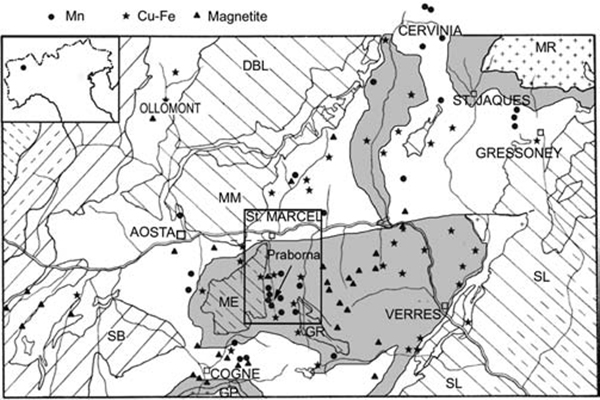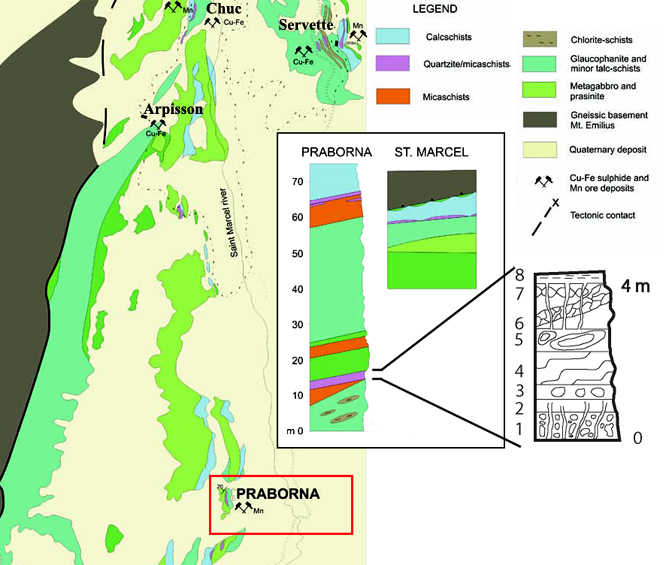Piemontite - Ca2(Mn,Fe)Al2(SiO4)(Si2O7)O(OH)
Named in 1853 by Gustav Adolph Kenngott for the type locality, the Piemonte region of Italy. Piemontite probably forms complete solid solution with all compositions of the clinozoisite-epidote series and differs from it by the presence of manganese. Less than 1% of Mn2O3 is sufficient to produce the pink-red colors and strong pleochroism that are probably the best defining characteristics of Piemontite. The most common occurrence of piemontite is in schists of low-medium grade regional metamorphism in association with chlorite, quartz and sericite. Piemontite may appear in Manganese deposits of metasomatic or hydrothermal origin.Optical properties:
• Form: Columnar, bladed or acicular crystals.
• Color: Pink, red
• Pleochroism: Strong, from red-pink to yellow.
• Relief: High
• Cleavage: Perfect basal cleavage (001).
• Interference colors: Mild to strong birefringence. Often masked by intense mineral color.
.jpg)
Elongated piemontite purple crystals associated with albite. Praborna mine, Aosta Valley, St. Marcel, Italy. From RRUFF.
.jpg)
Elongated piemontite purple crystals associated with albite. Muramatsu mine, Kinkai, Nagasaki, Japan. From RRUFF.
.jpg)
Elongated piemontite purple crystals associated with albite. Muramatsu mine, Kinkai, Nagasaki, Japan. From RRUFF.
Praborna Mine
In Italy, only three Mn deposits that are, or were, economically exploitable are known: 1) Praborna, 2) Gambatesa and 3) Mt Argentario ores. While the deposit of Mt. Argentario is belived to be of igneous origin, the other two Mn-deposits had a sedimentary origin since they actually developed in sediments that covered the seafloor of the Jurassic Tethys. Praborna is located in the St. Marcel valley (Aosta valley, Italy), in the western Italian Alps (Fig.1), and belongs to the lower part of the Piedmont Jurassic ophiolitic nappe, of oceanic origin. The Praborna Mn ore occurs within the meta-ophiolites of the Piemonte nappe, which extends along the entire arc of the Western Alps.
Fig. 1. Tectonic sketch map of the Aosta valley, showing Cu–Fe, Fe and Mn occurrences in the Piemonte Ophiolite Nappe (White unmarked: Combin unit. Grey unmarked: Zermatt-Saas unit). SB: Saint Bernard Nappe and Permo-Carboniferous Zone. GP and MR: Gran Paradiso and Monte Rosa Nappes. MM, DBL, ME and SL: Mount Mary, Dent Blanche, Mount Emilius and Sesia-Lanzo Austroalpine Nappes and Klippen. From Tumiati, S. (2005).
Praborna is by far the most important and famous Mn occurrence of the Piemonte nappe. Known since 1415 and described by de Saussure and Bertrand de Lom (1844). It is well known for very peculiar Mn-bearing assemblages and Sb, As, Ba, Sr and REE-rich minerals. Praborna is the type locality for a score of mineral species, namely piemontite, braunite, romeite and strontiomelane. In addition, some peculiar Mn-bearing mineral varieties have been observed and described at Praborna: Alurgite (a red Mn-bearing phengitic mica), greenovite (a pink-coloured titanite) and violan (a deep-violet omphacitic clinopyroxene).
The manganese deposit of Praborna (Fig.2) is composed of a boudinaged quartz-rich layer, which extends over about 100 m and ranges from 0.4 to 8 m in thickness. It is overlain by serpentinite, chlorite-schists and quartz-rich schists, contains a few intercalations of metapelites and metabasites, and lies on garnet+lawsonite glaucophanite. The metamorphic conditions of the manganese deposit are difficult to retrieve because conventional geothermobarometry and thermodynamic modelling cannot be straightforwardly applied to Mn-rich petrological systems. The presence at Praborna of glaucophanite with pseudomorphs after lawsonite indicates a P-T evolution across the lawsonite-blueschist subfacies during prograde metamorphism. The peak conditions of metamorphism in the St. Marcel valley have been estimated at Servette by Martin et al. (2008). The estimates of P= 2.1 +/- 0.3 GPa and T= 550°C +/- 60°C would place the metamorphic peak into the amphibole-eclogite facies, transitional to the blueschist facies.
TheMn-rich layers are highly variable in terms of mineral assemblage, reflecting variations in bulk composition and oxidation state. They display numerous bands that alternate at different scales. Nevertheless, the layering is not laterally continuous. At the mesoscale, the original layered structure appears deformed, resulting in isoclinal folds, boudinaged lenses and quartz-rich mylonite, transposed parallel to the foliation of the surrounding glaucophanite and serpentinite.

Fig.2: Geological map of the St. Marcel valley. Cu–Fe and Mn mines are shown for reference. The schematic lithostratigraphy of the whole St. Marcel valley and the detailed sequence of Praborna (with the numbering of the level) are also reported. From Tumiati, S. (2005).
Despite the complex structure, a type sequence was recognised by Martin-Vernizzi (1982), this sequence (Fig.2), comprises, from bottom to top:
• Level 0: The footwall of the Mn-rich horizon is in contact with the underlying garnet-bearing glaucophanite, partially retrogressed to prasinite. Micaschists and chlorite-schists also occur.
• Level 1: The basal Mn-rich level is a braunite- and clinopyroxene-rich layer. The pyroxene is a violet Mn-bearing omphacite-aegirine-augite solid solution (the so-called violan). This level is highly fractured. Quartz, piemontite, clinopyroxene, Na-Ca amphibole and carbonate occur in minor amount. Along the fracture planes, Mn-rich phengite (alurgite) occurs. Most of this level has now disappeared, as it was intensively mined for braunite.
• Level 2: this ore-body level is dominated by piemontite, braunite and quartz. Yellow layers of spessartine rich garnet are common. In late fractures, albite, microcline, piemontite , Na-Ca amphibole and barite occur. As and Sb minerals, such as ardennite and romeite, can be found as accessory minerals.
• Level 3: this is an irregular emerald-green layer (10-20 cm), composed of quartz and Cr-bearing, aegirine-rich omphacite . This layer contains uncommon accessory phases, e.g., native gold, Cr-rich epidote and Cr-rich muscovite (fuchsite).
• Levels 4, 5: these levels of Praborna contain calderite-rich garnet and minor hematite in a quartz-rich matrix (level 4). In some cm-thick layers, garnet grows together with a brownish aegirine-rich clinopyroxene (level 5) and dark-green Na–Ca amphibole.
• Level 6: this outer level is composed of cm thick pinkish-orange boudins of quartz, pyroxmangite, strongly zoned garnet, and dark-coloured manganocummingtonite.
• Level 7: the hanging wall of the ore, in contact with the country-rock, is composed of quartz, spessartine rich garnet and Mn-Ca carbonates (rhodochrosite, kutnahorite). Some Na-Ca amphibole also occurs.
• Level 8: the contact country-rock is a blueschist-facies quartz-rich schist (quartz + epidote + Na-amphibole + carbonate + phlogopite + garnet + hematite +/- phengite).
The sequence seems to reflect a decrease in Mn oxidation state from the braunite-piemontite-rich footwall, where Mn3+ prevails, towards the spessartine and carbonate-rich, Mn2+ -bearing layers of the hanging wall. Petrologically, four principal equilibrium can be distinguish: 1 a primary, higher-P peak assemblage; 2 an intermediate blueschist-facies retrograde assemblage; 3 a late low-P greenschist-facies assemblage; 3 weathering products.
• The high-P peak assemblage is exceptionally well-preserved in the levels 1, 2 and 3 (the core of the mineralisation), with omphacite (violan in level 1 and emerald-green omphacite in level 3) . The occurrence of piemontite (Sr rich) is mainly confined in these core levels. Other minerals stable in the high-P peak assemblage are rutile (Sb bearing), apatite (As bearing), braunite, hollandite, hematite and ardennite.
• Intermediate-P assemblages occur in the levels 1-3 mainly as symplectites after Jadeite-rich pyroxene (Jadeite -poor pyroxene +albite) and Si-rich phengite (Ba-rich K-feldspar + Mn-rich biotite), and as Na-Ca amphibole + albite associations. Piemontite also broke down into carbonate-bearing symplectites, probably linked to a late reaction with alkalis+CO2-rich fluids (Tumiati, 2005). Intermediate-P conditions are displayed by the outer levels 4-8, characterized by the substantial absence of Jadeite -rich clinopyroxene and the abundance of calderite-rich garnet that becomes spessartine and almandine-rich in proximity to the hanging-wall quartzite. Na–Ca amphibole (crossite) and/or aegirine/diopside-rich pyroxene can be present associated with garnet.
• The low-P greenschist-facies assemblages, generally observed in late veins, are characterised by albite, quartz, K-feldspar, titanite, amphibole (tremolite), barite, rhodonite, calcite, strontianite, witherite and chlorite.
Sample doned by Fulvio Malfatto.
Bibliography
• Griffin, W. L., & Mottana, A. (1982). Crystal chemistry of clinopyroxenes from the St. Marcel manganese deposit, Val d'Aosta, Italy. American Mineralogist, 67(5-6), 568-586.
• Tumiati, S. (2005). Geochemistry, mineralogy and petrology of the eclogitized manganese deposit of Praborna (Valle d’Aosta, Western Italian Alps). Unpublished PhD thesis, Universitadell’Insubria (Como)–Université Denis Diderot (Paris-7).
• Tumiati, S., Martin, S., & Godard, G. (2010). Hydrothermal origin of manganese in the high-pressure ophiolite metasediments of Praborna ore deposit (Aosta Valley, Western Alps). European Journal of Mineralogy, 22(4), 577-594.


.jpg)
.jpg)
.jpg)
.jpg)
.jpg)
.jpg)
.jpg)
.jpg)
.jpg)
.jpg)
.jpg)
.jpg)
.jpg)
.jpg)
.jpg)
.jpg)
.jpg)
.jpg)
.jpg)
.jpg)
.jpg)
.jpg)
.jpg)
.jpg)
.jpg)
.jpg)
.jpg)
.jpg)
.jpg)
.jpg)
.jpg)
.jpg)
.jpg)
.jpg)
.jpg)
.jpg)
.jpg)
.jpg)
.jpg)
.jpg)
.jpg)
.jpg)
.jpg)
.jpg)
.jpg)
.jpg)
.jpg)
.jpg)
.jpg)
.jpg)
.jpg)
.jpg)
.jpg)
.jpg)
.jpg)
.jpg)
.jpg)
.jpg)
.jpg)
.jpg)
.jpg)
.jpg)
.jpg)
.jpg)
.jpg)
.jpg)
.jpg)
.jpg)
.jpg)